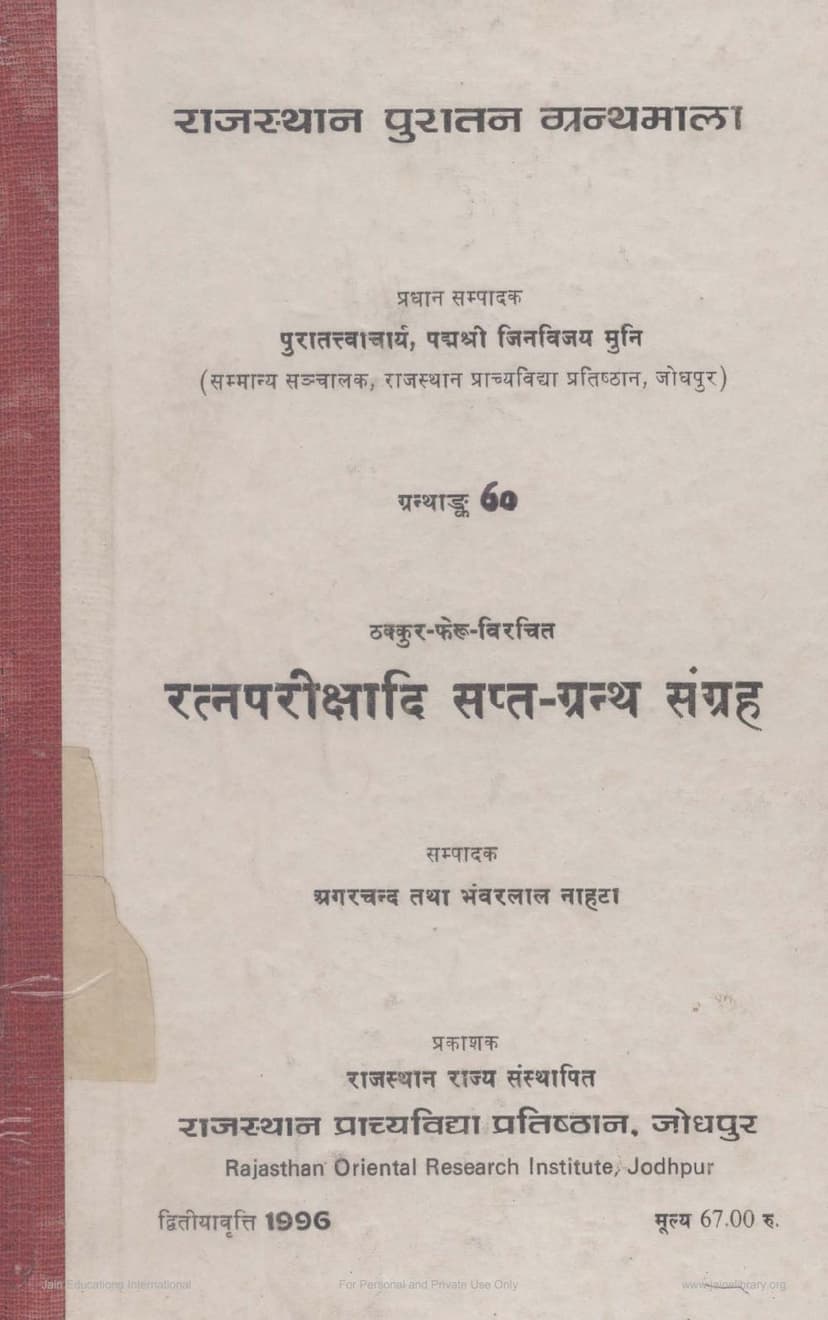Ratnaparikshadi Sapta Granth Sangraha
Added to library: September 2, 2025

Summary
Here's a comprehensive summary of the Ratnaparikshadi Sapta Granth Sangraha (A Collection of Seven Treatises Beginning with Ratnapariksha), compiled by Thakura Pheru, as presented in this volume:
Overview:
This collection brings together seven distinct works by Thakura Pheru, a notable Jain scholar and official during the 14th century, likely serving under Sultan Alauddin Khilji. The compilation is a significant contribution to the study of ancient Indian sciences and arts, covering a wide range of subjects. The works are presented in Prakrit, often with a colloquial flavor influenced by the prevalent Apabhramsha of the time. The collection was meticulously edited and published by Agarchand Nahta and Bhanvarlal Nahta, under the auspices of the Rajasthan Oriental Research Institute, Jodhpur, with the esteemed guidance of Padmashri Muni Jinavijaya.
Key Works and Their Content:
The seven treatises included in this collection are:
-
Ratna Pariksha (Treatise on Gemstones): This is considered the most significant work in the collection. It provides an in-depth analysis of various gemstones, detailing their origins, characteristics, classification, identification, value, and the methods used to distinguish genuine stones from fakes. Thakura Pheru draws upon his personal experience working with the royal treasury and earlier scholarly works. The text discusses the nine principal gems (Navaratnas) and their sub-varieties, colors, qualities, and defects, even touching upon their astrological significance and impact on wearers. It also includes discussions on metals, their properties, and processes. The text is notable for its inclusion of contemporary terminology for gems and trade practices, offering valuable insights into the medieval Indian gem market.
-
Dravya Pariksha (Treatise on Substances/Coins): This work is unique for its detailed account of the coins prevalent in India during Thakura Pheru's time. It describes their composition, minting locations, denominations, weight, and the names of rulers associated with them. The author meticulously details the process of refining metals and identifying alloys. This treatise is a crucial historical document for understanding the numismatics and economic history of medieval India.
-
Dhatutpatti (Origin of Metals): This treatise focuses on the origin and properties of various metals. It describes the processes for purifying and identifying different metals like gold, silver, copper, lead, and brass, along with their alloys. The text also delves into the properties of various minerals and substances like cinnabar, red lead, conch shells, camphor, agarwood, and musk, showcasing the author's extensive knowledge of alchemy and material sciences.
-
Jyotisha Sara (Essence of Astrology): This work is a comprehensive introduction to astrology, covering various aspects of the subject. It includes details on calculating auspicious days (Dina Shuddhi), planetary positions, lunar mansions (Nakshatras), constellations (Yogas), zodiacal signs (Rashis), and their influences. The text also elaborates on various astrological calculations, auspicious and inauspicious timings for activities, and the impact of planetary combinations. It is notable for its inclusion of detailed tables and charts (Yantras and Kundalis) for astrological predictions.
-
Ganita Sara (Essence of Mathematics): This is a foundational treatise on mathematics, covering arithmetic, algebra, geometry, and mensuration. It explains concepts like addition, subtraction, multiplication, division, squares, cubes, square roots, cube roots, fractions, and basic algebraic equations. The text also includes practical applications of mathematics in areas like measuring land, calculating quantities of goods, and determining the volume of various structures. It demonstrates Thakura Pheru's proficiency in mathematical principles and their application.
-
Vastu Sara (Essence of Architecture/Building Science): This work is a significant contribution to the field of Vastu Shastra, providing guidelines and principles for the construction of buildings, temples, and other structures. It discusses site selection, auspicious timings for construction, the planning of various architectural elements like foundations, walls, pillars, and roofs, and the placement of deities and other important features. The text emphasizes the harmonious integration of buildings with their surroundings and the principles of positive energy flow.
-
Khartara Gachchha Yugapradhana Chaturpadika (A Quaternary Verse on the Epoch-making Leaders of the Khartara Sect): This is a historical and genealogical work that lists the prominent Acharvas (spiritual leaders) of the Khartara sect of Jainism. It provides brief biographical details and significant achievements of these revered figures, tracing their lineage and contributions to the propagation of Jain teachings. The text highlights their intellectual prowess, spiritual achievements, and their role in shaping the history of the sect.
Author and His Context:
Thakura Pheru was a multi-talented individual who lived in the 14th century. His works reveal his deep knowledge in diverse fields such as gemology, numismatics, metallurgy, astrology, mathematics, and architecture. His association with the royal administration, likely in the mint or treasury of Alauddin Khilji, provided him with practical experience and access to valuable information, which he skillfully incorporated into his writings. His adherence to Jain principles is evident in his self-designation as "Param Jain" and "Jinendra Pada Bhakto," and his works are often dedicated to his son, Hemapal, for whom he wrote the Ratnapariksha.
Significance of the Collection:
This compilation is invaluable for several reasons:
- Preservation of Ancient Knowledge: It preserves knowledge on various subjects that might have been lost to time, particularly in the fields of gemology and numismatics.
- Historical Documentation: The works, especially Dravya Pariksha and Ratna Pariksha, serve as primary historical sources for understanding medieval Indian society, economy, trade, and material culture.
- Linguistic Value: The Prakrit language used by Thakura Pheru, with its colloquialisms and Apabhramsha influences, offers insights into the evolution of the language.
- Scholarly Research: The meticulous editing and annotation by the Nahta brothers and Muni Jinavijaya make this collection an indispensable resource for scholars and researchers in Indology, Jain studies, and history.
- Practical Guidance: The treatises on mathematics and architecture offer practical guidance and knowledge that were relevant in their time and continue to be of academic interest.
In essence, the Ratnaparikshadi Sapta Granth Sangraha is a treasure trove of knowledge authored by a remarkable scholar, offering a unique window into the intellectual and material world of 14th-century India.